The information paradox was first mooted by Stephen Hawking in 1976. For an introduction to the subject, see Brian Koberlein’s black holes tell no tales or do they? Then see Hawking’s paper on the breakdown of predictability in gravitational collapse. Hawking said information is lost down a black hole because the quantum emission is completely random and uncorrelated. He also said “this means there is no S matrix for the process of black-hole formation and evaporation”. The S-matrix is the scattering matrix which is to do with reversibility and conservation laws. For example you can perform pair production to create a proton and an antiproton, and you can annihilate a proton and an antiproton. Either way you start or finish with zero net charge, and charge is conserved. However you could start with two identical black holes and throw a succession of protons into one, and a succession of antiprotons into the other. In both cases the Hawking radiation is said to be the same, such that the black holes evaporate and charge is not conserved.
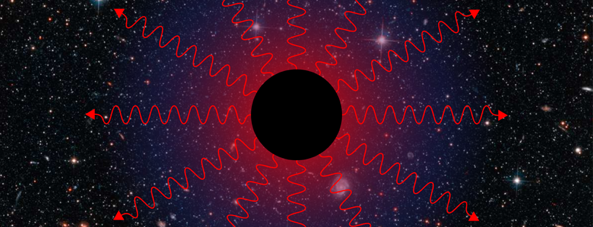 Image by APS/Alan Stonebraker from Hawking team updates soft hair theory to help solve black hole information paradox
Image by APS/Alan Stonebraker from Hawking team updates soft hair theory to help solve black hole information paradox
Hence Hawking said “there must be nonconservation of information in black-hole formation and evaporation just as there must be a nonconservation of baryon number”. As to why this should be contentious I don’t know. We don’t have gamma-ray bursters for nothing, and at the RHIC in Brookhaven they “melted” hadrons into a quark-gluon plasma. See the 2009 physicsworld article of gluons, atoms and strings . It says “such a plasma may have existed about 1s after the Big Bang”. We surely wouldn’t expect much in the way of information conservation in the chaotic early universe, especially since baryon asymmetry looks like proof of non-conservation of baryon number.
A slow start
It didn’t seem to be contentious in 1976. When you look at Hawking’s publications the earliest mention of “information” is 1996. In Matt Strassler’s information paradox article you can read about what Hawking showed in 1974-1975, and the next date mentioned is 1992. When you use Google scholar to look at citations for Hawking’s paper, there were none in 1976. There’s 1,941 as I write, but there were only 17 in 1977, and it looks like the only paper that continues the theme was black holes and unpredictability by Hawking himself. There were 9 citations in 1978, then 6 in 1979, but none of them concern information loss. There were 14 citations in 1980 but only one paper concerned information loss. That was is black-hole evaporation predictable? by Don Page. His paper was however somewhat critical, saying black holes may be no more unpredictable than other phenomena. There were 7 citations in 1981 including Hawking’s own paper interacting quantum fields around a black hole, and 8 in 1982, including Hawking’s own paper on the unpredictability of quantum gravity. I have to say the latter feels like clickbait for quantum physicists, particularly since Hawking talked of “virtual black holes which appear and disappear again”. The only paper that took the bait is again by Don Page: is quantum gravity deterministic and/or time symmetric? Again it’s somewhat critical. It ended up saying this: “the most conservative possibility still remains open [2], that H0 and H2 are trivial and that full quantum gravity gives an S matrix which is both deterministic and time symmetric”. I note that Hawking’s 1983 paper thermodynamics of black holes in anti-de Sitter space was co-authored with Don Page. I suppose that’s one way to silence a critic.
The black hole war begins
1983 was fairly quiet, with only 5 citations. However 1983 brought us the search for violations of quantum mechanics by John Ellis, John Hagelin, Dimitiri Nanopoulos, and Mark Srednicki. It refers to Hawking’s 1982 paper on the unpredictability of quantum gravity, and includes a rather ominous sentence: “so far there has been no contact between these theoretical speculations and experiment”. Talking of which, 1983 was also when Leonard Susskind and Gerard ‘t Hooft got involved. Susskind is of course the author of the black hole war, a book published in 2008. See the Washington Post for an excerpt: “Stephen claimed that ‘information is lost in black hole evaporation’ and, worse, he seemed to prove it. If that was true, Gerard and I realized, the foundations of our subject were destroyed”. Susskind talked about Wile E Coyote running off a cliff, and called Hawking half a cosmologist. Then he said this: “Stephen’s lecture was the last that day. For about an hour afterward, Gerard stood glaring at the diagram on Werner’s blackboard. Everyone else had left. I can still see the intense frown on Gerard’s face and the amused smile on Stephen’s. Almost nothing was said. It was an electric moment. On the blackboard was a Penrose diagram, a type of diagram representing a black hole. The horizon (the edge of the black hole) was drawn as a dashed line, and the singularity at the center of the black hole was an ominous-looking jagged line. Lines pointing inward through the horizon represented bits of information falling past the horizon into the singularity. There were no lines coming back out. According to Stephen, those bits were irretrievably lost. To make matters worse, Stephen had proved that black holes eventually evaporate and disappear, leaving no trace of what has fallen in”. To make matters even worse, Susskind said Hawking “postulated that the vacuum – empty space – was full of ‘virtual’ black holes that flashed into and out of existence so rapidly that we didn’t notice them. The effect of these virtual black holes, he claimed, was to erase information, even if there was no ‘real’ black hole in the vicinity”. Did you know that black holes were continually popping in and out of existence erasing information? Me neither. But Stephen Hawking said it, so it must be true.
The phoney war
In 1984 there were 11 citations for Hawking’s 1976 paper paper and 9 citations for his 1982 paper. One was is quantum gravity unpredictable? by David Gross. Again it’s a somewhat critical paper. It said “this analysis is incomplete and may be misleading”. Then it said “even if correct, Hawking’s scenario does not require a fundamental modification of the laws of physics”. But it lacked the killer punch, and it looks as if Gross was only using the issue as a vehicle to push his space-time foam. Meanwhile ‘t Hooft was getting some skin in the game with a paper on the ambiguity of the equivalence principle and Hawking’s temperature. A few months later Susskind co-authored a paper with Tom Banks and Michael Peskin talking about difficulties for the evolution of pure states Into mixed states. It says “we will show that the effects suggested by Hawking are very dangerous perturbations, leading either to nonlocal interactions, and, thus, to acausal signal propagation, or to large violations of energy-momentum conservation”. The paper also says “we should, properly, note that the precise proposal made in ref. [l] does not stand on an especially firm theoretical foundation”. Reference 1 is of course Hawking’s 1982 paper on the unpredictability of quantum gravity.
Connected universes
You can read some more history in Jeroen van Dongen‘s presentation can we understand the black hole information paradox debate by studying its history? Van Dongen talks about Susskind and Kuhn and paradigm shift. He says ‘t Hooft wrote a paper but Hawking was a referee and it was rejected. He also quotes ‘t Hooft saying this: “QG struck me as highly esoteric. No observations; what on earth are all those people doing?” And this: “my reaction was: non-unitary evolution is impossible. A black hole is just like other objects. Like a bucket of water”. Van Dongen also quotes Susskind saying Hawking “had put his finger on a clash of principles. The Equivalence Principle and Quantum Mechanics were on a collision course.” And this: “Only eight journal articles from that entire period address the question of information loss in black holes. I wrote one of them, and ’t Hooft wrote all the rest”. It isn’t quite true because there were papers such as a solvable model for irreversible quantum phenomena by Silvio Bergia et al. But there still wasn’t much interest, perhaps because it was all so esoteric, and all so far removed from experiment. For example in 1985 ‘t Hooft wrote a paper on the quantum structure of a black hole. He said black holes should be subject to the same QM rules as ordinary particles or composite systems, but he also wrote about black holes and particles as wormholes connecting two universes together:
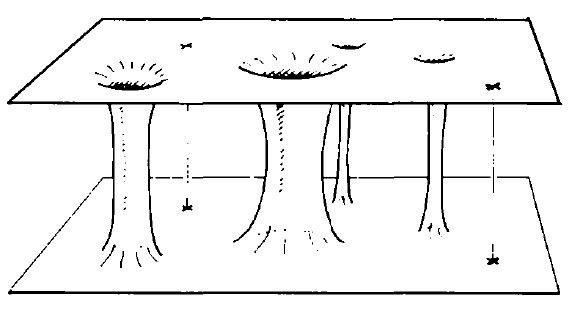 Image by Gerard ‘t Hooft, from on the quantum structure of a black hole
Image by Gerard ‘t Hooft, from on the quantum structure of a black hole
Van Dongen skipped over the years between 1985 and 1993. There are papers such the origin of nonunitarity in quantum gravity by Petr Hajicek in 1986, and the unitarity puzzle and Planck mass stable particles by Yakir Aharonov and others in 1987. But they didn’t attract much attention. Nor did ‘t Hooft’s 1989 paper on the black hole interpretation of string theory. That’s where “the picture emerges of a black hole horizon covered by a lattice of simplexes each of Planck size, and on every simplex i, quantum numbers li = 1/2, mi = ±1/2 can be added as if they were angular momenta”. No it doesn’t, which is presumably why his paper had only one citation in 1990, and only one in 1991.
The holographic principle
But at last things were picking up and Hawking was getting more bites. One noteworthy paper of 1991 was evanescent black holes by Curtis Callan, Steven Giddings, Jeffrey Harvey, and Andrew Strominger. They claimed collapsing matter radiates all its energy away before an event horizon has a chance to form. And that “matter asymptotically approaches a zero-energy ‘bound state’ which can carry global quantum numbers”. Zero-energy matter! Another noteworthy paper was do black holes destroy information? by John Preskill. He said “in the lively imagery of Susskind [13], a mysterious force must bleach the encyclopedia as it tumbles into the black hole”. He then offered five options: the information comes out with the Hawking radiation, or it’s retained by a remnant, or it comes out at the end, or it’s encoded in quantum hair, or it escapes to a baby universe. A baby universe! He also said “perhaps we are just being really stupid, and a crucial insight that has eluded us will allow everything to fall into place”. Quite. But he didn’t challenge Hawking radiation. If anybody else did they were buried in the scrum. In 1992 there were 25 citations for Hawking’s 1976 paper and 25 citations for his 1982 paper. In 1993 there were 45 citations for his 1976 paper and 26 citations for his 1982 paper. One of the 1993 papers was ‘t Hooft’s dimensional reduction in quantum gravity. Things were now snowballing, and the holographic principle was born. It’s “a supposed property of quantum gravity that states that the description of a volume of space can be thought of as encoded on a lower-dimensional boundary to the region”. Only we have no evidence for it whatsoever.
Black hole complementarity
Black hole complementarity was also born in 1993. Complementarity is to do with things like position and momentum. See the 1993 paper the stretched horizon and black hole complementarity by Leonard Susskind, Larus Thorlacius, and John Uglum. It said this: “if the black hole evaporates completely, that information would be lost, in violation of the rules of quantum theory”. It also said “the belief is based on the equivalence principle” and that “it seems certain that a freely falling observer experiences nothing out of the ordinary when crossing the horizon”. Unfortunately the equivalence principle doesn’t say that. It’s only valid in the infinitesimal. It only applies to a region of infinitesimal extent, and so to no region at all. However this was of no concern to Susskind et al, who instead waxed lyrical about their stretched horizon. They said “the membrane is very real to an outside observer. For example, if such an observer is suspended just above the stretched horizon, he or she will observe an intense flux of energetic radiation apparently emanating from the membrane”. They took Hawking radiation as gospel truth, then they gilded it and set it on a pedestal. Then they expected everybody to take this as gospel truth too: “if, on the other hand, the observer attempts to determine if the membrane is real by letting go of the suspension mechanism and falling freely past the stretched horizon, the membrane will disappear”. Now you see it, now you don’t! See the Science News mysterious boundary article for more. It mentions lots of physicists, but refers to Susskind most. If you’re lucky, you’ll see the popup that says ”credible science journalism is more important than ever”. Then you’ll see this: “he argued that information can simultaneously cross the event horizon and never cross the event horizon, so long as no single observer can see it in both places”. This is his elephant in two places at once:
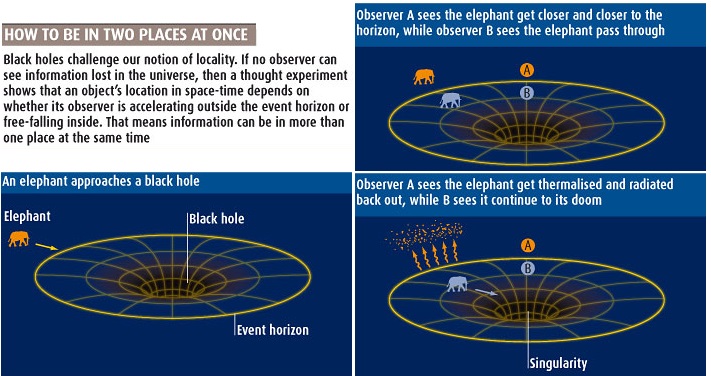 Image from the New Scientist article the elephant and the event horizon
Image from the New Scientist article the elephant and the event horizon
Susskind was also in two places in once because in 1994 he wrote a paper called the world as a hologram. He talked about “the yet to be discovered lattice version of interacting supersymmetric light front string theory”. He also said “in string theory the formation and evaporation of a black hole must be described by an S matrix because string theory is an S matrix theory. Obviously this is an unsatisfactory conclusion to the debate”. Obviously Susskind was using the information paradox as a vehicle to advance not just supersymmetric pseudoscience, but himself too.
Baby universes and umbilical cords
Another 1994 paper was a possible resolution of the black hole information puzzle written by Joe Polchinski and Andrew Strominger. They said “the problem of information loss is considered under the assumption that the process of black hole evaporation terminates in the decay of the black hole interior into a baby universe”. There’s that baby universes again! They gave three options, saying information is destroyed or comes back out or is stored internally eternally, and then said “in this paper we shall present a fourth alternative, which might be described as (iv) all of the above”. They have their cake and eat it. Plus they have a baby universe field operator. They even have umbilical cords which break. As you can imagine, it didn’t catch on. However the holographic principle did.
AdS/CFT correspondence
It caught on in a big way in 1997 via AdS/CFT correspondence. That’s the conjecture that there’s a relationship between two other conjectures. It was proposed in 1997 by Juan Maldacena in his paper on the large N limit of superconformal field theories and supergravity. Amazingly this is the most cited particle physics paper of all time. As I write, google scholar says it has 17,185 citations. So it must be true, particularly since it was in New Scientist. This is what New Scientist said: “In 1997, Maldacena developed a type of string theory in a universe with five large dimensions of space and a contorted space-time geometry. He showed that this theory, which includes gravity, is equivalent to an ordinary quantum field theory, without gravity, living on the four-dimensional boundary of that universe. Everything happening on the boundary is equivalent to everything happening inside: ordinary particles interacting on the surface correspond precisely to strings interacting on the interior”. It might sound impressive if you don’t know any physics. But it doesn’t take much to rain on this parade. Take a look at the illusion of gravity in Scientific American written by Maldacena himself. It says this: “physics in anti de Sitter space has some strange properties. If you were freely floating anywhere in anti de Sitter space, you would feel as though you were at the bottom of a gravitational well. Any object that you threw out would come back like a boomerang. Surprisingly, the time required for an object to come back would be independent of how hard you threw it”. Does that sound like any kind of gravity you know of? No, because we do not live in anti de Sitter space. Nor do we have any evidence of any unseen dimensions. But we have ample evidence that we live in a universe consisting of three spatial dimensions that offer freedom of motion, plus the time dimension derived from motion. However Maldacena would have you believe that “in actuality all the particles and fields that make up reality are moving about in a two-dimensional realm like the Flatland of Edwin A Abbott”.
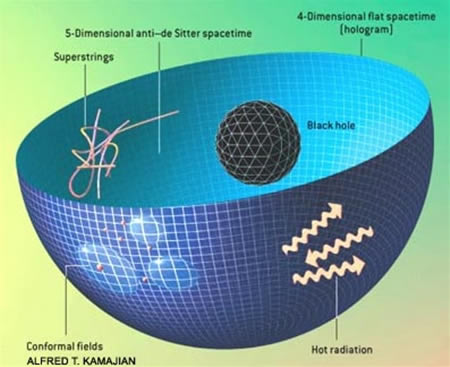 Image by Alfred Kamajian, see the the essentia article Information in the Holographic Universe: A Holographic Spacetime
Image by Alfred Kamajian, see the the essentia article Information in the Holographic Universe: A Holographic Spacetime
He would have you believe that gravity is “part of the illusion”, that there are 1060 colors, and that a thin boundary string is like a string close to the boundary, whereas a thick boundary string is like one far away from the boundary. This boundary is of course located out at infinity beyond experimental reach. Plus there’s a caveat in in that “an expanding universe, like ours, that comes from a big bang does not have such a well-behaved boundary. Consequently, it is not clear how to define a holographic theory for our universe; there is no convenient place to put the hologram”. But that’s OK, because Ed Witten proved that Maldacena’s conjecture was correct in his 1998 paper anti de Sitter space and holography. Even though conformal field theory is said to describe fundamental particles, but doesn’t. Even though as David Tong says, a conformal field theory cares about angles but not distances, whilst gravity does care about distance. Even though Maldacena thought spacetime curvature deflects the trajectories of particles and didn’t know about inhomogeneous space. He didn’t know how gravity works or what an electron is, so he got lost in maths. But that was fine because so did ten thousand others, because the information paradox was a great vehicle to popularize string theory. At the Strings 98 conference the string theorists sang the Macarena. They aren’t singing now.
The black hole war is over
But they were in 2004. That’s when Susskind won the black hole war, because Hawking gave in. Hawking said this: “in 1997, Kip Thorne and I bet John Preskill that information was lost in black holes. The loser or losers of the bet are to provide the winner or winners with an encyclopaedia of their own choice from which information can be recovered with ease. I’m now ready to concede the bet but Kip Thorne isn’t convinced just yet”. Hawking gave Preskill a baseball encyclopedia, and later joked that he should have given him its ashes. Hawking also wrote a paper on black holes and the information paradox for the GR17 conference saying quantum perturbations of the event horizon could allow information to escape. He also said this: “one can’t be sure a black hole forms, no matter how certain it might be in classical theory”. I rather think the hard physical evidence of Sagittarius A* says otherwise. Hawking said this too: “I’m sorry to disappoint science fiction fans, but if information is preserved, there is no possibility of using black holes to travel to other universes”. So if information is not preserved, a black hole is a gateway to the parallel antiverse! Where does that sit on the John Baez crackpot index?
What’s the upshot?
Jeroen van Dongen said more towards the end of his presentation. He said Susskind said the black hole war is over but “this claim may upset a handful of people who are still fighting it”, that many in the GR community “continued to be blinded by Hawking’s early arguments”, that Hawking is a “tragic figure”, and that holography is now “normal science”.
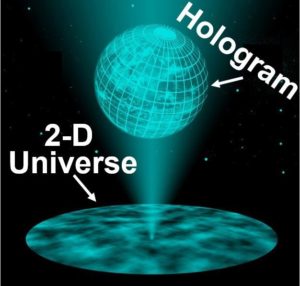 Image from steemit article holographic universe theory, original from physorg, credit Vienna university of technology
Image from steemit article holographic universe theory, original from physorg, credit Vienna university of technology
Van Dongen said Susskind was very certain, claiming that Maldacena and Witten had proved “beyond any shadow of a doubt” that information would not be lost. But van Dongen also said there’s no deductive certainty to the AdS/CFT correspondence. He said most people in GR just don’t care, that AdS/CFT is not liked by them, and that there are many reasons to have reservations. But not if your name is Susskind. Van Dongen said Susskind was dismissive of Hawking’s change of mind, like the Dutch saying about being offered mustard after the meal. He also said ‘t Hooft was unhappy with the whole thing. He wasn’t the only one, as the questions made clear. One member of the audience made the point that the great decider called experiment has been left behind. One woman talked about GR contributions which are not covered, wherein when you remove the central singularity, there’s a way to remove the horizon, and then there’s no information paradox any more. I’m not happy either. Susskind said he won the war, but it was a phoney war invented to drum up publicity for pseudoscience tosh. A war that nobody won, but a war that physics lost. In response to Hawking saying a black hole destroys hadrons, we’ve now got strings and branes and holographic universes and baby universes and parallel universes and the assertion that the physical world is made of information, with energy and matter as incidentals. I think it’s crystal clear that the black hole information paradox has been an ideal vehicle for quacks and charlatans to promote themselves and their hypothetical handwaving. An ideal vehicle for a symbiotic media to peddle quantum mysticism. And an ideal vehicle to turn cosmology from physics into fantasy.
Paradox regained
It’s been an ideal vehicle because it’s conveniently divorced from experiment, which is why the story still rumbles on. See Ethan Siegel’s 2015 blog article have we solved the black hole information paradox? His subtitle is “or is this an example of the media hype surrounding Hawking going nuts?” He referred to Sabine Hossenfelder who dutifully reported proceedings from Stockholm in her 2015 blog article Hawking proposes new idea for how information might escape from black holes. She said Hawking “now understands that information is stored on the black hole horizon in form of super-translations”. These supertranslations are apparently caused by the ingoing particles. She said it was painful to watch, and referred to New Scientist reporter Jacob Aron who wrote an article entitled Stephen Hawking says he has a way to escape from a black hole. Aron referred to Hawking’s collaborator Malcolm Perry who said “things can get out of a black hole both on the outside and possibly come out in another universe”. The proposal is on the arXiv as the information paradox for black holes. The subsequent paper was soft hair on black holes. This isn’t just any kind of soft hair. This is Hawking and Perry’s zero-energy soft hair. You can read all about it on the register article Stephen Hawking reckons he’s cracked the black hole paradox by Richard Chirgwin. Apparently an infalling electron crossing the event horizon leaves a ghost of itself in this soft hair. Oh, and it would seem that black holes are portals to a parallel universe after all. No wonder people like Jim Baggot and Alexander Unzicker are so critical. In the FQXi article black holes: paradox regained Steve Giddings says the big question is where did we go wrong?
Paradox lost
Where did we go wrong? At the very beginning Steve, at the very beginning. With the Hawking horseshіt that somehow found its way into Nature. Even though it flatly contradicted Einstein, because Hawking didn’t know how gravity works. It’s like Tim Maudlin says in his 2017 paper information paradox lost: “the so-called ‘information loss paradox’ arises rather from the inaccurate application of foundational principles, involving both mathematical and conceptual errors”. He says the problem ought to have been dismissed 40 years ago, and that recent attempts to solve the problem are blind alleys. He says Wald’s key observation is that Σ2 is not a Cauchy surface. He says this: “so the transition from the physical state on Σ1 to the physical state on Σ2 is a Cauchy-to-non-Cauchy transition. That means that there never has been any grounds to expect the transition to be either retrodictable or unitary. Quantum Theory does not imply, and never has, that such a transition must be retrodictable or unitary or ‘preserve information’. There were no grounds in 1975, and remain no grounds today, to expect information to be preserved”. Well said that man.
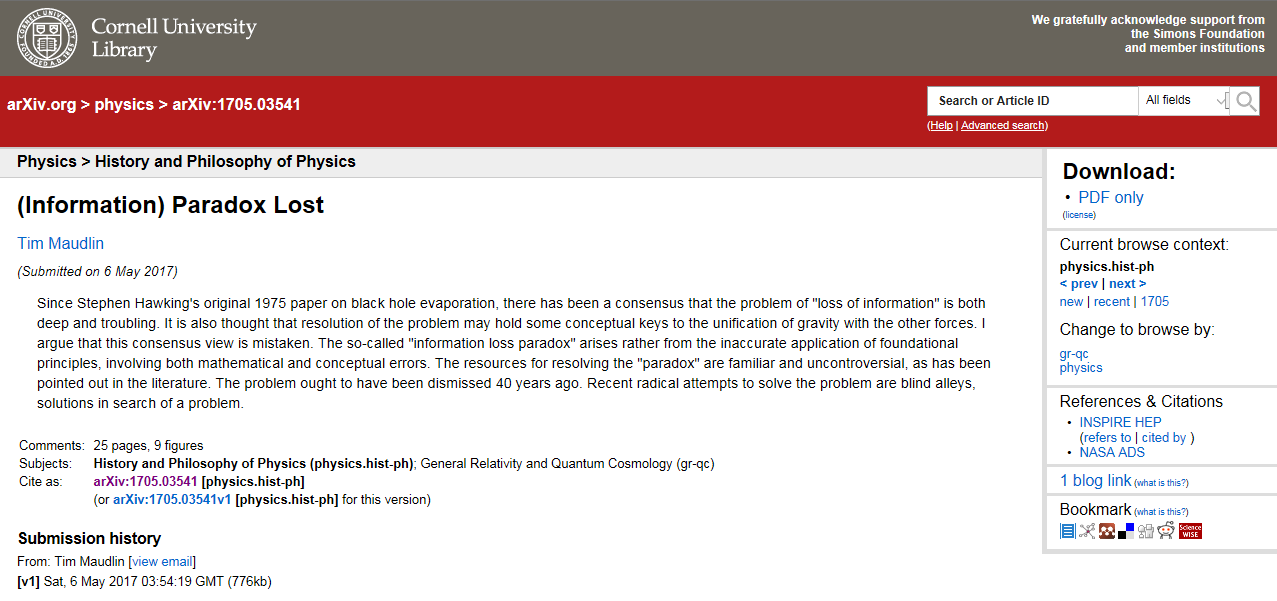 Screenshot from the arXiv, see https://arxiv.org/abs/1705.03541
Screenshot from the arXiv, see https://arxiv.org/abs/1705.03541
Maudlin says some other things too. I rather liked this: “this logical situation undercuts any pretension that the ‘information loss paradox’ holds clues of how to proceed in quantizing gravity”. There’s also this: “so with regard to the question of whether the ‘information’ ever ‘escapes’ from the black hole, the AdS/CFT Conjecture is quite useless”. And then there’s this: “commit It then to the flames; for it can contain nothing but sophistry and illusion”. He also says forty years of effort have been directed at a non-problem. And that people should articulate what’s wrong with his paper, and if they can’t, then all the talk about the information paradox ought to cease. Along with all the talk about black hole complementarity. And all the talk about firewalls.
Firewalls
Ah, firewalls. As it happens I don’t agree that all the talk about firewalls ought to cease. That’s because whilst there’s no evidence for Hawking radiation, or the information paradox, or for the holographic principle, there’s plenty of evidence for the black hole firewall. But it’s perhaps not the firewall you think it is. Because like I said, we don’t have gamma-ray bursts for nothing.